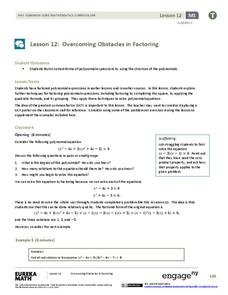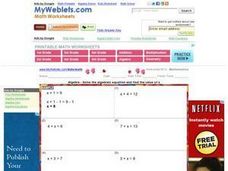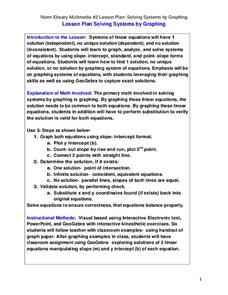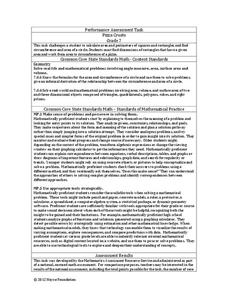EngageNY
Overcoming Obstacles in Factoring
What do you do when factoring doesn't work? Learners complete the square when faced with quadratic expression that don't factor traditionally. They then use factoring by grouping to solve polynomial equations.
Education Development Center
Making Sense of Unusual Results
Collaboration is the key for this equation-solving lesson. Learners solve a multi-step linear equation that requires using the distributive property. Within collaborative groups, scholars discuss multiple methods and troubleshoot mistakes.
National Institute of Open Schooling
Electrochemistry
In an electrolytic cell, electrical energy is converted into chemical energy, the exact opposite of a battery! Lesson 15 in a series of 36 explores electrochemistry. Participants begin by reading and discussing oxidation/reduction...
Mascil Project
Container Logistics
Here's a creative lesson that lets pupils be creative as well! While considering many different factors, learners devise a plan to increase the efficiency of container shipments. The design of the activity encourages creative,...
Mascil Project
Closed Greenhouses
Controlling the efficiency of a greenhouse is a mathematical task. A collaborative project challenges learners to create an efficiency plan for a closed greenhouse. Using algebraic equations, they consider a set of constraints, design...
Illustrative Mathematics
Security Camera
A different-than-normal problem that allows learners to practice their reasoning to find an answer. The problem bases itself off a graph drawing of a store that needs to install security cameras. The challenge is to find which placement...
Curated OER
Equations
In this equations worksheet, 4th graders solve 4 equations by testing the values for x = 3, 4, 6, and 9. Students solve 8 equations mentally or by testing values for n.
Curated OER
Solving One-Step Addition Algebraic Equations
In this algebraic equations worksheet, students solve nine one-step linear equations by subtracting. A sample problem is provided as well as the solutions.
Curated OER
Nine Solving Algebraic Equations Problems
In this solving algebraic equations worksheet, students solve nine equations for the variable a. A sample problem and the solutions are provided.
Curated OER
Solving Systems by Graphing
Learners solve systems of equation through graphing. In this algebra lesson, students solve linear equations and analyze the result to figure out if there is one solution, no solution or infinitely many solutions. They graph their lines...
Curated OER
Systems of Equations in Two Variables
In this algebra worksheet, pupils work with pairs of linear equations. Three problems ask students to determine if the given ordered pair is a solution of the system of equations. Pupils graph two systems to determine the solution.
Mathed Up!
Quadratic Formula
Young scholars explore how to solve any quadratic equation with a video about the quadratic formula. They then use the quadratic formula to solve a set of quadratic equations.
Texas Instruments
TI-Nspire™ CAS
When it comes to rating educational calculators, this calculator is always near the top of this list. Now it's available as an app. There is a lot of calculator power wrapped up in this app. Not only is this a fully functioning...
EngageNY
Using the Quadratic Formula
What is the connection between the quadratic formula and the types of solutions of a quadratic equation? Guide young mathematicians through this discovery as they use the discriminant to determine the number and types of solutions,...
Illustrative Mathematics
Walk-a-thon 2
During a walk-a-thon your learners must determine the walking rate of Julianna's progress. Using tables, graphs, and an equation, they must be able to calculate the time it took her to walk one mile and predict her distance based on the...
Noyce Foundation
Pizza Crusts
Enough stuffed crust to go around. Pupils calculate the area and perimeter of a variety of pizza shapes, including rectangular and circular. Individuals design rectangular pizzas with a given area to maximize the amount of crust and do...
West Contra Costa Unified School District
Solving Systems of Inequalities
Don't throw away those transparency sheets just yet! Young scholars first review inequalities on a number line, then learn about graphing inequalities in the coordinate plane. Finally, they use overhead transparencies to create systems...
EngageNY
A Surprising Boost from Geometry
Working with imaginary numbers — this is where it gets complex! After exploring the graph of complex numbers, learners simplify them using addition, subtraction, and multiplication.
Firelands Local Schools
Exponential Growth and Decay
How can you safely model exponential growth and decay? A hands-on activity uses candies to model not only exponential decay, but also exponential growth. Exponential equations are fitted by hand and by use of a calculator...
Curated OER
Points of Intersection
Young scholars solve systems of equations. In this solving systems of equations lesson, students look for the intersection of the two lines in the system. Young scholars solve systems that have one solution, no solution, and...
Curated OER
Graphing Linear Functions
Students practice solving systems of linear equations using the substitution and elimination methods. They determine if the system has one, infinite or no solution. Students also graph the linear equations.
101 Questions
Coin Counting
Cash in on a great resource. After watching a video of a coin counter, pupils estimate the number of coins and the amount of money they see. They then use additional given information and systems of equations to find the actual values.
Balanced Assessment
Telephone Service
Class members must determine the best phone plan for customers. by assessing three different phone plans. Each plan price depends not only the number of minutes, but also the location of the calls — bringing in a third variable. Scholars...
Curated OER
Equal Sums
Make addition a game! As learners become more familiar with addition, they can incorporate this equal sums matching activity into their practice time. The materials (included) are twenty-four cards, each with a simple addition problem...























